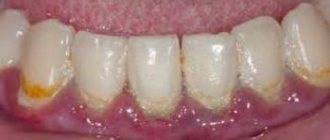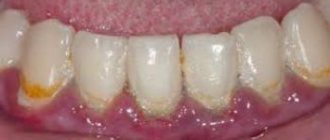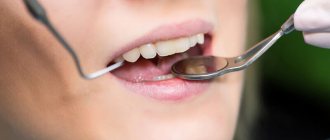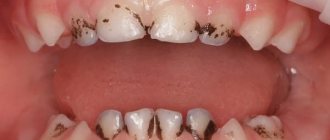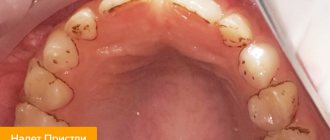In most cases, dental plaque is the cause of insufficient oral hygiene. But it also happens that people who are very sensitive to hygiene issues develop black plaque on their teeth.
The reasons for its appearance in adults and children differ : if in the former it is a consequence of drinking large amounts of tea and coffee, as well as smoking, then in the latter it may be associated with the activity of certain bacteria, the use of mouthwashes and the use of chewable vitamins.
The process of formation of dark plaque on teeth -
As we said above, dark plaque on teeth is formed due to various pigments that are deposited on the surface of the teeth. But to be completely precise, it is thanks to chromophores (these are compounds in pigments that determine their color). Chromophores can be of organic and inorganic origin. For example, organic chromophores include the so-called polyphenolic compounds, which include “tannins”, “furfural”, etc. These compounds can be found in coffee, tea, wine and fruits.
Tobacco smoke (polyphenols, etc.) also contains a large number of dark-colored pigments of organic origin. As for inorganic chromophores, these include metal ions - primarily Fe 2+ and Fe 3+ (divalent and trivalent iron), Cu 2+ (divalent copper), as well as Mn 2+ (divalent iron). valence manganese). And I think - everyone now understands that the formation of pigmented plaque on teeth occurs due to the deposition of organic and inorganic chromophores on the surface of the teeth. A particularly interesting process will be the deposition of metal salts on the teeth of children and adults, which we will discuss in detail below.
Important: dark plaque on teeth forms much more slowly if the surface of the teeth is clean and does not have a layer of soft microbial plaque or hard tartar. But, if there is soft microbial plaque on the teeth that has not been properly removed (during oral hygiene), or there is already a tightly attached layer of partially mineralized plaque, then in this case the pigments are integrated into their structure much faster.
Those. to the bacterial film on the surface of the teeth, as well as to a rough surface (for example, fillings) - pigments will “stick” much faster than to a completely clean tooth surface. The same applies to tartar, which is dental plaque mineralized by calcium salts contained in saliva (primarily calcium phosphate). And chromophores, i.e. pigments - they can integrate perfectly even into the crystal lattice of calcium phosphate, which, together with bacteria, makes up tartar.
Dark plaque on teeth from smoking, tea and coffee -
Yellow or brown plaque on teeth can most often be found in patients who smoke or drink strong coffee or tea. Below we will once again present 2 photographs in which we ask you to pay attention to the following. Both patients have plaque on their teeth (especially a lot of soft microbial plaque). We have already said above that pigments hardly adhere to clean tooth enamel, but very quickly attach to the layer of microbial plaque.
Pigment + bacterial plaque –
But if with stains from tea and coffee everything is quite simple, and they can be attributed simply to superficial pollution, then with smoking things are more complicated. On the one hand, some of the pigments contained in tobacco tar will indeed remain only on the surface of the tooth enamel, and in the future this pigment plaque can be removed without problems. But on the other hand, experienced smokers may experience a change in the physiological color of the enamel and even dentin, which is associated with prolonged penetration of the resin into the depths of the hard tissues of the tooth (this occurs through many micro-cracks on the surface of the enamel). And such pigmentation cannot be changed by professional teeth cleaning, and chemical whitening will be required.
But yellow plaque on teeth can form not only among lovers of tobacco, strong tea or coffee. Pay attention to the photo of the lower teeth below. This patient does not smoke, does not abuse coffee or tea, but in this patient, in the area of the necks of the teeth, a layer of partially mineralized dental plaque is clearly visible, which is already tightly attached to the tooth enamel and can no longer be cleaned off with a regular toothbrush. Those. The problem here, again, is not related to excessive consumption of coffee or tea, but, first of all, to insufficient oral hygiene. As a result of this, the completely soft microbial plaque that has not been removed begins to mineralize and at the same time turns a little yellow.
Partially mineralized dental plaque –
Important: drinks and food products that contain a large amount of pigments - dark-colored carbonated drinks, beets, wine, tea or coffee, spices, berries and some fruits (24stoma.ru). If the tooth enamel is not covered with a layer of microbial plaque, then such products can only temporarily change the color of the tooth enamel (for example, many people notice that immediately after drinking wine their teeth turn blue for a short time). But in the presence of dental plaque, pigments penetrate into the structure of the latter, remaining in it for a long time.
Other causes of darkening of teeth -
Some ingredients in oral care products can stain your teeth. First of all, we are talking about such a common antiseptic as chlorhexidine, which is included in many toothpastes and mouth rinses. The same effect can be caused by the antiseptic benzalkonium chloride, which can be included not only in some mouth rinses, but also in some dental gels (an example is Kamistad gel).
Long-term use of rinses and toothpastes containing essential oils can also lead to darkening of your teeth, because the latter are also polyphenolic compounds (eg Listerine mouthwash). But here it should be noted that black plaque on teeth as a result of the use of antiseptics and essential oils does not appear in all patients. The fact is that darkening occurs only on those surfaces of the teeth on which there is a layer of microbial plaque. And it is possible that while this coating was light, you simply did not notice it. But in any case, such darkening will be reversible.
Dark plaque after using chlorhexidine -
Another common ingredient in hygiene products that can lead to darkening of teeth is stannous fluoride (SnF2), which is included in some toothpastes as an anti-caries component. There is a scientific paper about this at the link above. The fact is that pigments (chromophores) can also be formed by chemical processes of initially colorless compounds. In addition, stannous fluoride can react with volatile sulfur compounds produced by oral bacteria to form tin sulfide (SnS2). This can cause plaque-covered tooth surfaces or demineralized areas of enamel to turn yellowish.
But! Dark plaque on teeth can occur even with good oral hygiene, and even if you do not smoke or drink strong tea or coffee. This formation mechanism is associated with the vital activity of chromogenic bacteria in the oral cavity, which primarily includes actinomycetes. Most often, the formation of such plaque occurs in children, but adults are no exception (see photo below).
Black plaque produced by chromogenic bacteria -
Diseases of the body
Black plaque on the upper and lower teeth can occur in those who have general systemic diseases of the body. Most often, pathology appears if a person has problems with the gastrointestinal tract: high acidity, gastritis, ulcerative lesions, dysbiosis, gastroduodenal reflux (when bile from the duodenum is thrown into the stomach or from the stomach into the esophagus), bending of the gallbladder. Teeth can turn black due to problems with the liver and kidneys, bile ducts, and dysfunction of the endocrine system.
Removing black plaque or performing whitening procedures in a dental office will be short-lived, ineffective and pointless if you are not going to treat the underlying disease of the body that caused the problem.
Problems with the gastrointestinal tract can also cause the problem
Black plaque on a child’s teeth –
As we said above, the mechanism of deposition of insoluble metal salts on teeth will work not only in children, but also in some adults. The fact is that in the oral cavity there are bacteria called actinomycetes. They are anaerobic bacteria and are often called chromogenic bacteria. It is these bacteria that are responsible for the appearance of black or tightly attached plaque, located circularly in the area of the necks of the teeth (Fig. 10-12). Sometimes such plaque may have a brown or greenish tint.
Black plaque in a child -
According to various statistics, the formation of dark plaque occurs in 1 to 20% of all children, and the process itself occurs as follows... Actinomycetes, in the course of their life activity, release hydrogen sulfite, which enters into a chemical reaction with iron compounds contained in saliva. As a result, an insoluble form of iron is formed (with impurities of calcium and phosphorus), which is deposited on the teeth in the form of a black plaque. Moreover, this happens even in patients with high-quality regular oral hygiene.
Scientific studies have shown that the deposition of black plaque in the form of insoluble iron salts is associated with 2 main factors. Firstly, we are talking about the species composition of the microflora of the oral cavity, i.e. The higher the content of actinomycetes in the oral cavity, the higher the risk of black plaque formation. Thus, one of the scientific studies showed that in children aged 6-12 years with black spots, actinomycetes were sown in 70% of cases, and in children without black spots - only in 20% of cases. And this shows an obvious dependence.
In addition to actinomycetes, bacteria of the genus Prevotella, for example, P.gingivalis and P.intermedia, can also lead to the deposition of insoluble iron salts. But they show such activity only if a child or adult has concomitant gum inflammation, manifested by bleeding. Those. These bacteria extract iron from red blood cells that enter the mouth during gum disease, turning it into black plaque. Thus, the presence of gingivitis in the patient is another risk factor.
The connection between black plaque and drinking water –
Scientific studies show that drinking unfiltered tap water, as well as water purified by osmosis, increases the risk of deposition of insoluble iron salts in the form of black plaque by 13 times (you can read the clinical study at this link). How to remove such plaque - read at the very end of the article.
How to remove black plaque on teeth -
If you only have a not too pronounced dark plaque on your teeth (in the absence of tartar or a thick layer of pigmented plaque), its amount can be reduced using an Oral-b electric brush and a special toothpaste with increased abrasiveness. We'll cover this method below, but keep in mind that this will only work on a thin layer of plaque.
How to remove plaque on teeth if a thick layer of plaque has formed or there is already tartar - in this case, you should immediately contact your dentist for professional teeth cleaning. Professional cleaning will completely remove all external contaminants from your teeth, but if you are an experienced smoker and pigmentation of the hard tooth tissues themselves (enamel and dentin) has already occurred, then chemical bleaching may also be required.
Prevention
Thorough oral hygiene is the key to dental health! A small black dot will not appear on the tooth unless the patient uses metal objects instead of a toothpick. There should be no microscopic damage to the gums and enamel, then infections will not appear. Since teeth are living organs, mineral and vitamin deficiency should be avoided. To do this, balance your diet, and if necessary, take complexes with vitamin and mineral supplements. Visit the dentist regularly. Visits to the doctor at least once every six months will allow you to identify diseases in a timely manner.
Removing dental plaque at the dentist -
Depending on the amount of plaque and tartar, as well as the equipment of the dental office, the dentist can use the following methods or a combination of them:
- ultrasonic cleaning + conventional mechanical polishing (carried out using a polishing brush and paste),
- ultrasonic cleaning + Air-Flow,
- Air-Flow only.
a) Cleaning dental plaque using Air Flow –
The Air-Flow method is something like sandblasting. From a special tip under high pressure, a water-air mixture with particles of an abrasive-polishing substance is supplied to the tooth surface. This method works great if your layer of pigmented plaque is not too thick and there are no massive hard dental deposits. But if they do exist, then the dentist will first remove the massive deposits with ultrasound and, using Air-flow, polish your teeth, removing all the smallest irregularities and plaque residues.
How to get rid of plaque using Air-flow –
b) Removal of dental plaque using ultrasound –
Ultrasound cleaning of plaque is the most common and most versatile method. Its advantage is that with the help of ultrasonic cleaning devices (scalers) you can remove pigmented plaque of any severity, as well as the most massive hard dental deposits. The cost of the procedure averages from 150 to 200 rubles per 1 tooth, but there are clinics where this service can cost even 400-500 rubles (per 1 tooth).
A nozzle is inserted into the tip of the ultrasonic scaler, the tip of which oscillates at ultrasonic frequency during the procedure, and during the oscillation process water is supplied generously to the tip of the nozzle. As a result of mechanical contact of the nozzle with dental plaque, the attachment of the latter to the tooth is destroyed. The cavitation mechanism also works in parallel. It lies in the fact that the propagation of ultrasonic waves in an aqueous environment leads to the formation of many air bubbles, which burst with the occurrence of hydrodynamic impacts (this leads to cleansing of the tooth surface).
Removing plaque using ultrasound (video) –
After ultrasonic cleaning, tiny particles of plaque (irregularities) always remain on the surface, which must be removed. This can be done either using Air-flow, or using traditional teeth polishing using a rotating polishing brush with bristles and a special polishing paste. If polishing is not done, the tooth surface will remain rough, which will lead to the rapid adhesion of new portions of microbial and pigmented plaque to the teeth.
How to remove plaque from teeth at home -
You can remove plaque from your teeth at home using a combination: an Oral-b electric brush + a special teeth polisher.
As the latter, you can use, for example, PRESIDENT White Plus toothpaste, which has an abrasiveness of RDA 200. But the best option is to buy a special dental polishing paste that the dentist uses. The best option for such polishing pastes is Detartrine or Detartrine Z (the latter is better, but more expensive). Oral-b toothbrush and Detartrine series toothpastes:
You can use the Oral-b electric toothbrush every day, and in fact, these brushes are made exactly like a dentist's tool for polishing teeth from plaque. But the special tooth polishing pastes mentioned above are not intended for daily use, but only for periodic processing. Such pastes are capable (even without the use of ultrasonic cleaning) of removing not only moderate pigmentation plaque, but even small tartar.
But still, it would be optimal to first undergo professional oral hygiene at the dentist, and use our recommendations as “regular maintenance therapy.” In addition, it should be taken into account that the home method of removing plaque mentioned above has special requirements for the process of carrying out this procedure, which you can read in the article at the link below.
→ Removing stone and plaque
Caries in the spot stage: diagnostic measures
The most reliable and effective diagnostic procedure for the initial form of caries is to check the integrity of tooth enamel using special organic dyes. Dentists use:
- carmine;
- tropeolin;
- methylene red;
- methylene blue.
The latter is more often used in dental practice. First, the specialist removes accumulated plaque from the tooth surface. Use cotton swabs to isolate the tooth from saliva and then apply the coloring solution. After a few minutes, the solution is thoroughly washed off and the condition of the enamel is analyzed. If it is stained, this indicates the presence of caries.
There are other ways to diagnose caries in the spot stage:
- drying of enamel. The surface of the tooth is treated with a solution of hydrogen peroxide, then the enamel is thoroughly dried with a stream of warm air. After drying, areas with white spots will immediately become noticeable;
- radiography. The area affected by caries appears as a small spot on an x-ray. The method is used mainly for contract caries;
- examination with a stomatoscope. First, all accumulated plaque is removed from the surface of the teeth, then the dentition is illuminated with the device. Under ultraviolet radiation, it is not only easy to distinguish damaged tissue from healthy tissue, but it is also possible to determine the boundaries of pathology.
In order to treat caries in the spot stage, it is very important to undergo a timely diagnosis, accurately recognize the presence of pathology and exclude similar diseases that resemble caries.
Black plaque on a child’s teeth: treatment
Both pigmented microbial plaque and chromogenic staining of teeth due to the activity of actinomycetes bacteria are removed equally in both children and adults, but there are nuances depending on age. For example, Air-flow can be used no earlier than from 12-15 years of age (at the discretion of a specialist), ultrasonic cleaning can be used from 14 years of age. Therefore, in younger children, removal of dark plaque is carried out only with the help of a polishing brush and paste.
Removing dark plaque from a child (before and after photos) –
The main problem with removing pigment plaque caused by chromogenic staining (deposits of insoluble iron salts) is that usually the black plaque returns within 2-3 weeks. Therefore, you don’t really go to the dentist. And in order to prevent the reappearance of black plaque as much as possible, you need to follow the recommendations from the list below.
Prevention of chromogenic staining –
- solve the problem with drinking water (we already said above that drinking ordinary tap water, as well as water purified by an osmotic filter, increases the risk of stains by 13 times),
- stop taking chewable forms of vitamins,
- if you have bleeding gums, you need to see a dentist and have gingivitis treated,
- if you use pastes with stannous fluoride, switch to pastes with sodium fluoride or amino fluoride,
- use toothpastes that contain pyrophosphates, sodium citrate, polyaspartate, as well as polydone and bromelain (all these components prevent pigments from attaching to tooth enamel),
- use toothpastes with lactoferrin (this glycoprotein has the ability to bind 2 trivalent iron ions per 1 molecule),
- Buy your child an Oral-B electric toothbrush (from 3 years of age).
All this will reduce the risk of black plaque deposits, and thanks to an electric toothbrush, you can also polish your child’s teeth yourself. Here it is necessary to clarify that many models of Oral-B electric toothbrushes are for adults - in some modes they can also be used by children from 4 years old, but under the supervision of adults. By the way, you can read about how lactoferrin prevents the formation of black plaque from insoluble iron salts in an English-language study at this link.
Comments
Recently, my wisdom tooth, which had been in for sooo long, finally came through completely. But it came out black and ached a little when pressed. What could it be?
Alice (04/12/2020 at 5:14 pm) Reply to comment
- Dear Alice, perhaps the wisdom tooth was affected by caries, pulpitis or periodontitis even before it completely broke through. You need to be examined by a dentist to find out the cause of the problem and begin treatment. If treatment is not practical, the tooth will have to be removed.
Editorial staff of the portal UltraSmile.ru (04/17/2020 at 09:17) Reply to comment
I heard that some materials that dentists use to treat teeth can cause blackening of the enamel. Is this really so, what to fear during treatment?
Lyubov Vladimirovna (04.05.2020 at 12:21) Reply to comment
- Dear Lyubov Vladimirovna, in the past, dentistry actually used materials that could cause darkening of teeth, for example, silver amalgam fillings, but today they are not used, so treat your teeth without fear.
Editorial staff of the portal UltraSmile.ru (05/11/2020 at 09:20) Reply to comment
I have a very dark coating on my nylon dentures, can I bleach it?
Alexander Mikhailovich (05.28.2020 at 22:17) Reply to comment
- Dear Alexander Mikhailovich, nylon absorbs various dyes well and requires daily and very careful care. Unfortunately, artificial denture materials cannot be bleached. You, of course, can try to clean them with special tablets or take them to the dentist for professional cleaning, but such a measure will not remove deeply ingrained pigment; it will only remove superficial stains and destroy bacteria.
Editorial staff of the portal UltraSmile.ru (06.06.2020 at 14:09) Reply to comment
